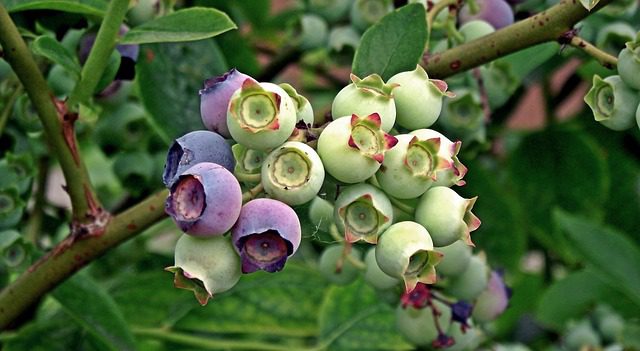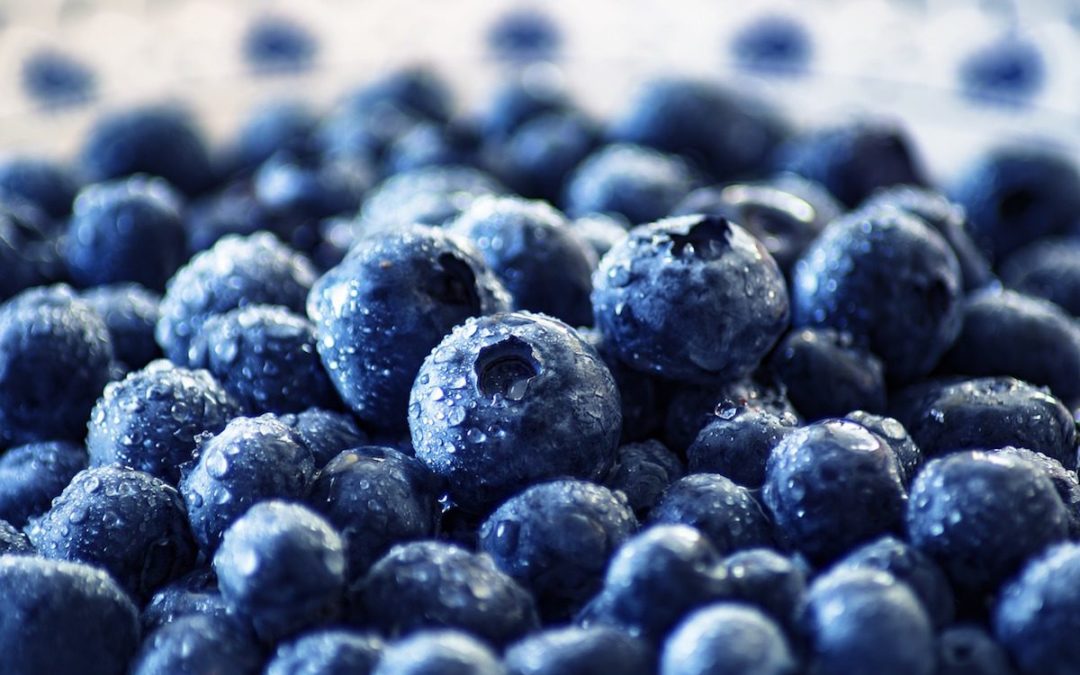Have you thought of growing blueberries in your San Antonio landscape? Rainbow Gardens thinks that is a great idea! Not only do blueberries provide you with sweet and juicy, fruits, they also make attractive landscape specimens in fall when their foliage takes on gorgeous orange, red, or purple hues. Right now is a great time to plant blueberries and other fruits. Let’s take a peek at what you need to be successful in growing them.
The Basics of Growing Blueberries
Types of blueberries: The absolute best type of blueberry to grow in Texas are the rabbiteye varieties or Vacinnium ashei. These blueberries produce best in our climate and offer bountiful harvests. A few of our time and true rabbiteye variety faves are: ‘Brightwell’, ‘Tifblue’’, ‘Premier’, ‘Pink Lemonade’ and ‘Powderblue’.
Cross pollinators: Whenever you are growing fruits and berries, it is generally recommended to purchase two different varieties of plants for cross pollination that will increase fruit production. When it comes to blueberries, this is not only the general recommendation, but the rule. You simply must buy two plants if you want a good harvest. Ex: plant ‘Premier’ with ‘Brightwell’ or ‘Brightwell’ with “Tifblue’ or ‘Powderblue’. Even if a tag claims that the blueberry bush is somewhat self-fertile, that is exactly what it is, somewhat. You will always get a better harvest by cross pollinating.
Cross pollinators: Whenever you are growing fruits and berries, it is generally recommended to purchase two different varieties of plants for cross pollination that will increase fruit production. When it comes to blueberries, this is not only the general recommendation, but the rule. You simply must buy two plants if you want a good harvest. Ex: plant ‘Premier’ with ‘Brightwell’ or ‘Brightwell’ with “Tifblue’ or ‘Powderblue’. Even if a tag claims that the blueberry bush is somewhat self-fertile, that is exactly what it is, somewhat. You will always get a better harvest by cross pollinating.

Soil requirements: Acidic soil is one of the most important things to remember that you need in order to grow blueberries successfully. It is important to keep in mind that blueberries need the proper pH level of 4.0 – 5.5 (no higher) in order to survive and thrive. If you don’t know yet, the soil in San Antonio is generally an alkaline soil (non acidic), so growing the plants in containers is how most of us can create the proper growing environment for our blueberries. A 30 gallon container is optimal, and your container must have adequate drainage holes.
- Soilless peat-based mixes are a great option to achieve proper acidity in a growing medium. Using a ratio of ⅓ peat moss to ⅔ finely shredded pine mulch is a good combo.
- You can even use 100% peat moss to grow your blueberry plant in. If you choose to create your own potting mix, use rich, organic matter and remember that adding more peat moss is never a bad thing when it comes to growing blueberries. You can buy test kits to check the pH of your soil from time to time to make sure you are on the right track.
- Plant your blueberries no deeper than they originally were planted in their nursery containers. Planting too deep will cause the health of your plant to suffer and it might not recover.
Light requirements: Like most edibles, these berries love the sunshine; 8 hours of full sunshine is recommended at a minimum. Although blueberries are somewhat more tolerant of SOME shade, berries grown in too much shade will slow, or may even stop, production of fruit. So keep an eye on the shade your trees may cast on your blueberry bushes as the years go by. A prune here and there to your trees may be needed to let the light stream in as your bushes grow.

Water requirements: Blueberries like even, moist, soil environments. Not too wet, not too dry. Soil mixes must drain well, and care must be taken during our hot summers to ensure soil never completely dries out. Organic pine bark mulch can help with water conservation and it also slowly releases acidity into the soil.
Fertilizers: Fertilizer needs to be used very sparingly with blueberries. No fertilizer should be applied at planting, and you should wait for a year after planting to assess growth. If you find after the first year that your blueberry bush has not grown vigorously, you can offer an acidic, granular fertilizer (like that designated for azaleas). Again, use sparingly.
Pests and Disease: Fortunately, blueberries are rarely bothered by pest and disease issues. This, and the mere fact of their bountiful production, is one of the reasons we still recommend blueberries as a satisfying fruit option for San Antonio (despite our lack of acidic soil). As long as they are kept healthy, the pests that bother blueberries will likely be minimal. You will most likely encounter ornery birds that swoop in to reap your harvests. Plant nets can fix that easily, and you can swoop in often and harvest those delightful blue orbs, full of delicious and healthful antioxidants, first.
There you have it. Those are the basics of growing blueberries. See? It IS a good idea to add blueberries to the fruit you want to grow.
~The Happy Gardener, Lisa Mulroy
Fertilizers: Fertilizer needs to be used very sparingly with blueberries. No fertilizer should be applied at planting, and you should wait for a year after planting to assess growth. If you find after the first year that your blueberry bush has not grown vigorously, you can offer an acidic, granular fertilizer (like that designated for azaleas). Again, use sparingly.
Pests and Disease: Fortunately, blueberries are rarely bothered by pest and disease issues. This, and the mere fact of their bountiful production, is one of the reasons we still recommend blueberries as a satisfying fruit option for San Antonio (despite our lack of acidic soil). As long as they are kept healthy, the pests that bother blueberries will likely be minimal. You will most likely encounter ornery birds that swoop in to reap your harvests. Plant nets can fix that easily, and you can swoop in often and harvest those delightful blue orbs, full of delicious and healthful antioxidants, first.
There you have it. Those are the basics of growing blueberries. See? It IS a good idea to add blueberries to the fruit you want to grow.
~The Happy Gardener, Lisa Mulroy


I have never grown blueberries but want to grow some.
1. Will you plant and pot the for my yard? And deliver. Or plant here. Install.
2. If I buy 3 which varieties do you suggest? What size do you have? I would like 3 gallon or 5 gallon.
3. Do you have pots for them? Do you carry the soils you need for them?
What are your prices?
I am thinking of a Satsuma tangerine also mine died.
I am passing on the phone number for Ray at our Thousand Oaks location. He is one of our employees that does deliveries and planting. He will also know which blueberries are currently stock for your selection. As far as pots go, we do carry pots large enough to hold blueberries, but honestly we have such a large assortment, you would need to come and choose which pots you would like as it would be difficult for anyone to describe and go through the inventory. We carry bagged potting soils as well. Ray can help you choose those. Here is phone number to see what his delivery schedule is and if he might be able to help you out. 1 (909) 414-6255
Will the deer eat all my blueberries? If so, how to keep them away.
Yes it is possible that deer will eat your fruit. Fencing, scare tactics and other things to deter deer can help but when deer are hungry they go after anything and fruits are very susceptible. I am attaching one of our blogs with some ideas for preventing deer in your landscape. Scare tactics for deer.
I bought a blueberry bush from you recently called Jelly Bean. Should I get a second variety for cross pollination and if so what do you recommend? Thanks
Hi Michele,
Your Jelly Bean blueberry is a hybrid half highbush, and a self-fertile variety, but you are correct that including a cross-pollinator would be beneficial for increased yields and a prolonged harvest period. If you choose to purchase another, I would advise looking for a ‘Southmoon’ or ‘Powderblue’ as those are both southern highbush varieties and would do well with cross pollinating your variety. (We also tend to carry those.) Good timing on your question, because I just released another blueberry post on cross pollination, you can check it out here.
I happened just to grab Sunshine variety at HEB but sadly it’s not on the best for this area. Will go for a couple more rabbit eye soon then in large containers. What is sunshine? Btw love your store! I was in Mexico for a year recently and can’t wait to visit.
Sunshine is a southern highbush variety. While they are self pollinating, they do best when offered a cross pollinator. While rabbiteye blueberries may be the best, you don’t have to give up on your Sunshine blueberry. Southern highbush are next in line for our (usually) mild winters.
Would you know what variety of Blueberry that HEB sells as the frozen product?
No, I am sorry, we are not privy to that information.